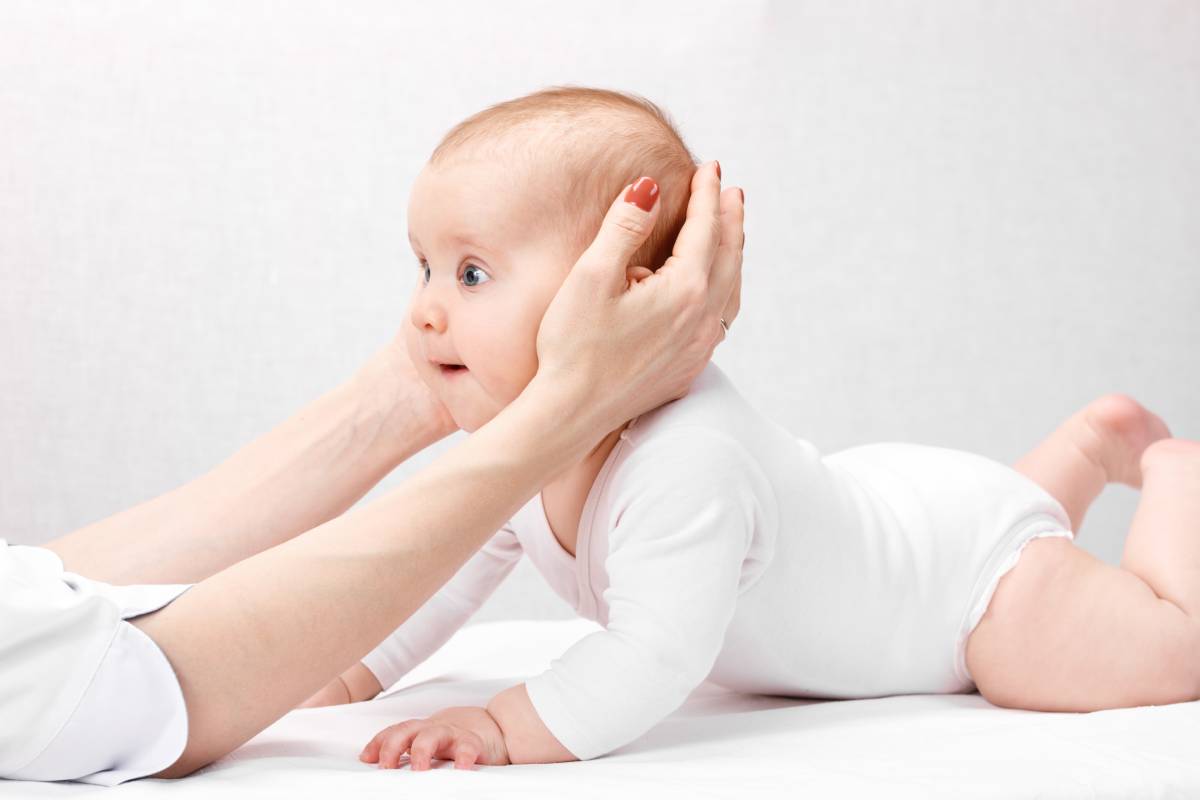Infant torticollis manifests when the sternocleidomastoid muscle, connecting the breastbone and collarbone to the skull, is shortened as a result of musculoskeletal or non-musculoskeletal factors 1, either at birth in the form of congenital torticollis, or later on in development in the form of acquired torticollis. The worldwide incidence of congenital torticollis varies from 0.3% to 1.9 %, with some studies pointing to a prevalence of 1 in 250 newborns, representing the third most frequent congenital orthopedic anomaly 2. An early diagnosis of newborn torticollis facilitates its swift noninvasive correction, such as through chiropractic care, minimizing any long-term complications. With proper treatment, 90% to 95% of children improve during their first year of life, and 97% of patients improve if treatment is begun prior to six months of age 3.
There are several methods of treating congenital torticollis. Physical and chiropractic therapy and repositioning are recommended as a first line treatment option. Such initial treatment focuses on passive range stretching and thorough patient follow ups, including manual flexion, extension, and lateral rotation stretches. Good stabilization and correct hand positioning are key, although stretching methods and positions are highly patient-centric 4.
A 2015 case study demonstrated that chiropractic management of infantile torticollis fully resolved the torticollis and associated abnormal fixation of the right eye 5. Chiropractic treatment consisted of cervical spine manipulative therapy alongside neck muscle massage and stretching; all symptoms resolved within 4 weeks.
Since, chiropractic manipulation under anesthesia has been developed as a novel therapeutic method. In a 2018 retrospective case series, 6 infants aged 4.5- to 15-months-old previously diagnosed with newborn torticollis, after failing to respond to conservative therapy options, were treated by a chiropractic doctor. All 6 infants, who were found to have arthrogenic newborn torticollis, responded well to manipulation under anesthesia 6, experiencing a significantly improved cervical range of motion. Manipulation under anesthesia may represent a therapeutic option for complex arthrogenic torticollis cases failing to respond to other adjunctive therapies.
Most recently, a 2020 case report documented the full resolution of an infant’s congenital torticollis using a multidisciplinary chiropractic approach. The treatment consisted of a gentle manipulation of the occipito-atlantal spinal region, soft tissue therapy of the sternocleidomastoid muscle, and cranial manipulation alongside a number of home exercises and a referral to a physiotherapist 7. Since, a 2020 systematic review assessing the effectiveness and safety of conservative interventions for torticollis at all ages corroborated that practitioner-led stretching and repositioning practices represented low risk, inexpensive interventions with tremendous potential for treating newborn torticollis 8. Finally, alongside these interventions, both Kinesio Taping and helmet therapy, primarily for infants with moderate to severe and persisting asymmetry, provide additional chiropractic care tools for the treatment of newborn torticollis 4.
Research has highlighted the positive outcomes of a multidisciplinary approach to correcting pediatric torticollis. Parents should remain well-educated as regards the condition and its prognosis, alongside proactively participating in its management. In concert, healthcare providers should remain aware of the association between congenital torticollis and its impact on a child’s gross motor developmental milestones. In the end, prompt, patient-adapted therapy from a collaborative team will remain key to sustainable clinical outcomes 3.
References
1. Haugen, E. B., Benth, J. Š. & Nakstad, B. Manual therapy in infantile torticollis: A randomized, controlled pilot study. Acta Paediatr. Int. J. Paediatr. (2011). doi:10.1111/j.1651-2227.2011.02145.x
2. Congenital torticollis – Physiopedia. Available at: https://www.physio-pedia.com/Congenital_torticollis.
3. Gundrathi, J., Cunha, B. & Mendez, M. D. Congenital Torticollis. Anaesthesia, Pain Intensive Care 20, 376 (2021).
4. Öhman, A. M. The Immediate Effect of Kinesiology Taping on Muscular Imbalance for Infants With Congenital Muscular Torticollis. PM R (2012). doi:10.1016/j.pmrj.2012.04.006
5. Hobaek Siegenthaler, M. Chiropractic management of infantile torticollis with associated abnormal fixation of one eye: A case report. J. Chiropr. Med. (2015). doi:10.1016/j.jcm.2014.12.003
6. Paravicini, I. Manipulation Under Anesthesia in Infants With Arthrogenic Newborn Torticollis: A Retrospective Case Series. J. Chiropr. Med. (2018). doi:10.1016/j.jcm.2018.04.004
7. Lacerte, F. D. D. Positive outcome from a chiropractic multidisciplinary approach for congenital torticollis in an infant three-weeks of age: A case report. J. Clin. Chiropr. Pediatr. (2020).
8. Ellwood, J., Draper-Rodi, J., Carnes, D. & Carnes, D. The effectiveness and safety of conservative interventions for positional plagiocephaly and congenital muscular torticollis: A synthesis of systematic reviews and guidance. Chiropractic and Manual Therapies (2020). doi:10.1186/s12998-020-00321-w
